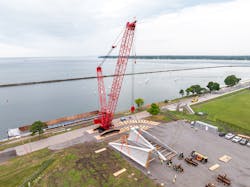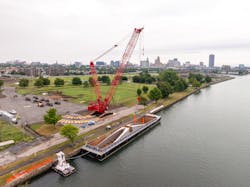The Bridge That Crossed the Atlantic
Bridges often span waterways, but this is a story about one that traveled over waterways, by boat and by barge, as it made its way from Italy to Buffalo, N.Y. And when it finally arrived at its destination, it was greeted by a Manitowoc 18000 lattice boom crawler crane from ALL Crane Rental of Pennsylvania, a member of the ALL Family of Companies.
The 266-foot pedestrian bridge was manufactured by world-renown Italian bridge-maker Cimolai to be foot traffic’s showpiece gateway to Buffalo’s new Ralph Wilson Park, spanning railroad tracks and six lanes of Interstate 190 below.
Resembling a steel taco with intricate latticework up the sides, the tied-arch bridge is heralded as an architectural marvel. It garnered intense media coverage throughout western New York, including newspaper articles, frequent TV updates, and a social media account dedicated to tracking its progress. The bridge traveled the Atlantic Ocean, through the Erie Canal, stopped in Albany, and was finally loaded in four sections onto two barges and sent to the shore of Wilson Park in Buffalo.
“The Manitowoc 18000, with its 660-ton capacity and 400-foot maximum reach, was specified for the job because of how far away the crane would have to set up, due to soft ground closer to shore,” said Keith Duell, sales representative with ALL Crane Rental of Pennsylvania. “It was configured with 180 feet of main boom to handle 170,000 pounds at a 100-foot radius.”
The bridge was separated into four large pieces by the manufacturer in preparation for shipment. Now back on solid ground, it was up to ALL’s customer, Danny’s Construction, a steel erection specialist based in Minnesota, to re-assemble the bridge under the direction of a Cimolai representative who flew into Buffalo for the operation. The bridge would be reassembled away from the final placement site using full-penetration welds, with no bolts used to join the four sections.
The Manitowoc 18000 offloaded the first two bridge sections on July 16th, then waited four days for the next barge to arrive with the final two pieces. Once all sections were offloaded, the crane had to move to a nearby hill where assembly would take place.
It was a delicate process, requiring ground mats to line the crane’s pathway, using the “mat-jumping” technique where the same mats, once behind the crane, are repositioned in front of it to allow progress to continue.
Ground on the hill was augmented with 22-inches of imported gravel and compacted road base, and the crane was always positioned atop ground mats when picking up the bridge segments for further support. From its position on the hill, the crane was able to reach the bridge sections near the shoreline and deliver them to the assembly area.
Danny’s Construction created 16 temporary bolsters, each seven feet tall, onto which the Manitowoc 18000 needed to place the four bridge sections for assembly. Proper placement was a meticulous process, requiring full-time engineering and survey support to direct adjustments of fractions of an inch. Next, the sections needed to be pulled together in preparation for welding. The fit-up tolerance for welding the segments together dictated that every connecting component of the bridge, at all three splices, simultaneously be within a plus or minus one-eighth-inch gap.
“Each section had steel plating guides to assist with precisely aligning the splices for welding,” said Joe Colley, project manager for Danny’s Construction. “It was like putting a plug into a socket – but a 660-ton crane was executing the movements with 170,000-pound bridge sections.”
The team at Danny’s fabricated a spreader bar especially for the rigging used in these maneuvers. The pick points on each bridge section had been thought out well in advance as well. “Our team worked with Cimolai more than a year prior so the pick points could be incorporated into the design of the bridge,” said Colley.
After the four sections were assembled and fully welded, the Manitowoc 18000 was disassembled and removed from the site, after approximately two weeks on the job. Danny’s Construction has remained on the site, putting finishing touches on the bridge, including decking.
When the completed bridge is delivered for final placement, self-propelled modular transporters, also known as hydraulic trailers and often referred to by the brand name Goldhofer, will be employed. They will roll under the bridge’s temporary supports, take on the completed bridge, then roll over ground mats atop the railroad tracks and the interstate. Gantry cranes will be used to set it in final position. That part of the operation is expected to happen in early October.
The result will be a bridge that is already well-traveled before the first person steps across it.
About ALL
The ALL Family of Companies is the largest privately held crane rental and sales operation in North America, operating under the ALL, ALT, Central, Dawes, and Jeffers names. For a rental quote: 800-232-4100 or www.allcrane.com.

